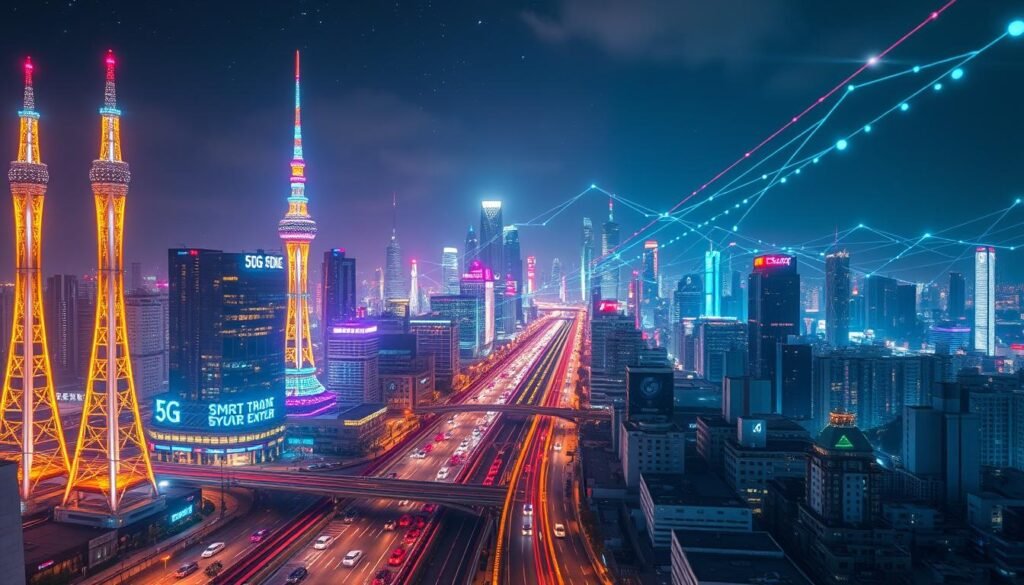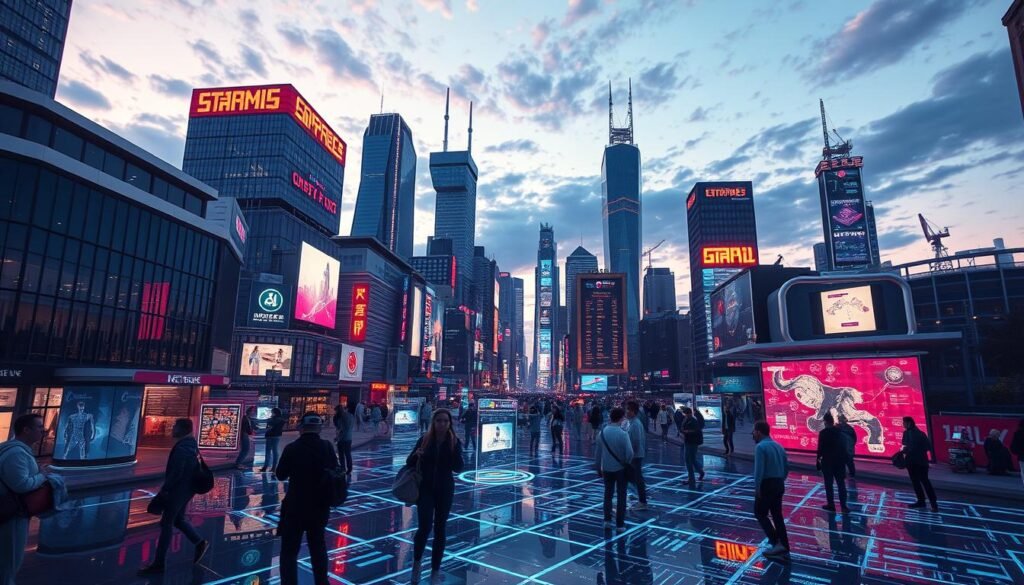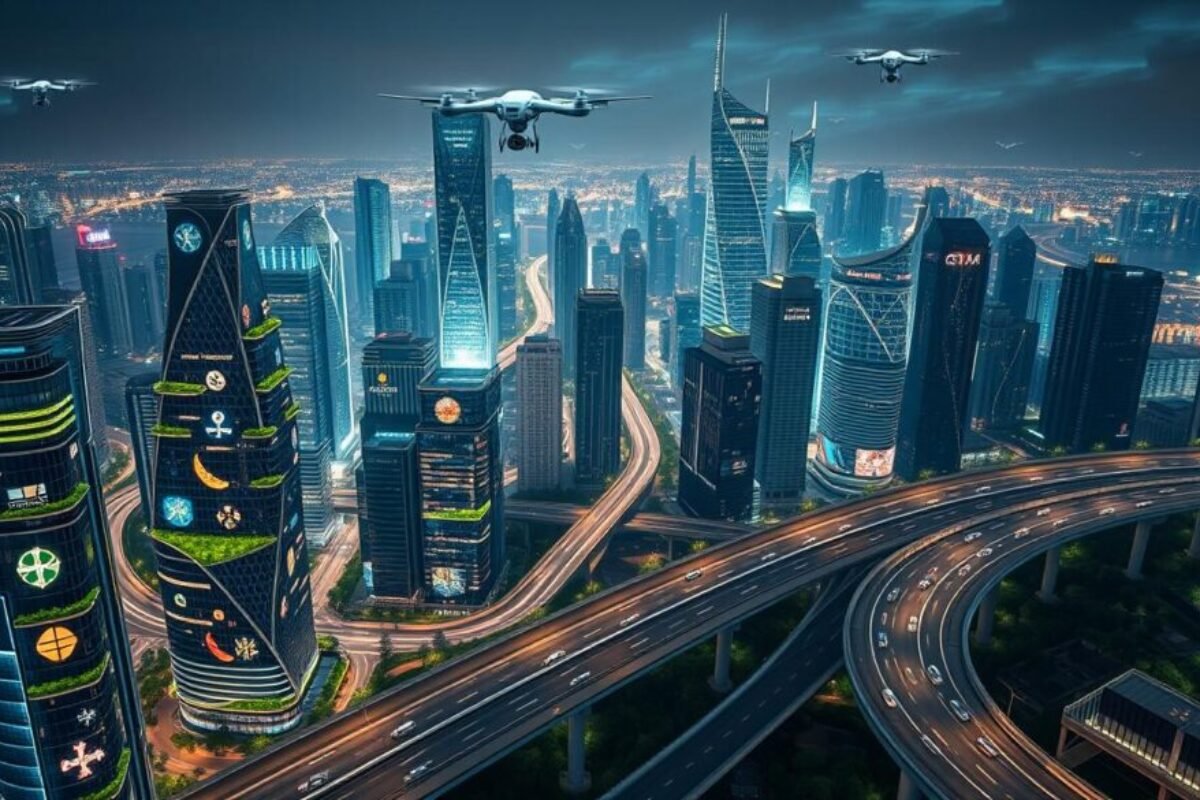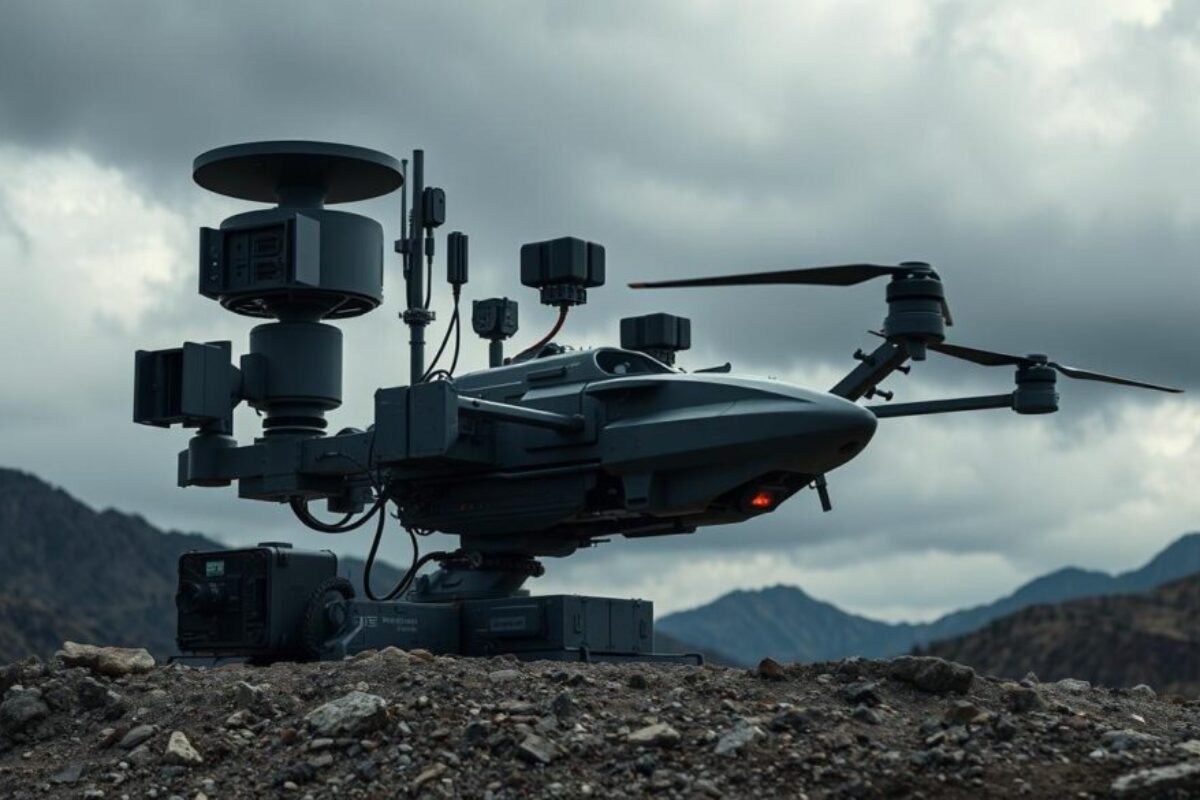Smart Innovations: Top 10 Breakthroughs in 2024
Smart Innovations are driving the future as technology advances rapidly. In 2024, IT spending is projected to hit $5 trillion, ushering in a new era of breakthroughs like Generative AI and Quantum Computing, poised to transform how we live and work.
This article looks at the top 10 tech trends for 2024. It shows us the power of smart innovations, futuristic technology, AI advancements, and cutting-edge inventions. Get ready to see how these innovations will change the world, affecting industries, economies, and society.
Key Takeaways
- Global IT spending is forecasted to increase by 8% in 2024, reaching $5 trillion.
- Generative AI and Robotic Process Automation (RPA) are transforming industries with their widespread adoption.
- Data Science and Big Data Analytics are reshaping industries by extracting insights from vast amounts of data.
- Quantum Computing promises unparalleled computational power, revolutionizing various applications.
- 5G Technology is revolutionizing connectivity with unprecedented speeds and reduced latency.
Smart Innovations of 2024: A Revolutionary Era
The year 2024 brings us into a new era, changing the world in big ways. These smart gadgets and new ideas are making things more automated and helping us make better choices. They’re changing everything from healthcare to finance2.
These tech breakthroughs are also changing how we work and live. They’re creating new jobs and making old ones more efficient2. But they also bring new challenges, like how we interact with technology3.
Impact on Global Industries
Smart innovations are changing many industries, like manufacturing and healthcare. AI is making things more efficient, and advanced analytics help us make smarter choices2. The Internet of Things (IoT) and digital twins are also helping us use resources better and manage risks3.
Economic Transformations
The economy is changing fast, thanks to these new technologies. New business models and more productivity are emerging2. But, there are also challenges like finding the right talent and getting enough money2. Despite these, the future looks bright, with a focus on being green and sustainable3.
Social Changes and Adaptations
These smart innovations are changing how we live and interact. They’re changing how we learn and use technology, bringing both good and bad changes2. They’re making our devices more personal, changing our lives in many ways4.
“The smart innovations of 2024 are reshaping our world, ushering in a new era of unprecedented technological progress and societal transformation.”
Quantum Computing Breakthroughs and Applications
In 2024, quantum computing is making big strides, moving from theory to real-world use in many fields5. It’s teaming up with artificial intelligence to change how we find new medicines, predict financial trends, and improve logistics5. This could solve problems that old computers can’t handle5.
2024 saw quantum computers beat traditional supercomputers in certain tasks, a major achievement6. This has made computers ten times faster, helping with data, learning, and solving complex problems6.
Quantum cryptography has also made big strides, creating secure communication channels that can’t be hacked6. This boosts security, as quantum computers could break old encryption methods7.
The drug discovery field is already using quantum computing to speed up finding new medicines6. The finance world is also benefiting, with better fraud detection and risk analysis thanks to quantum computing6.
But, there are challenges like keeping errors low and dealing with cooling needs6. Despite this, more money is going into research and education, preparing for a future where quantum computing changes everything5.
The future of quantum computing looks bright, with big chances to change many industries and solve hard problems7. With ongoing progress and teamwork, we’re on the verge of seeing quantum computing’s big impact.
“The field of quantum research has seen significant investment from both public and private sectors in 2024, indicating a promising future for quantum computing and its applications in various industries.”6
Advanced AI and Machine Learning Systems
Artificial intelligence (AI) and machine learning (ML) are leading the tech world. They help automate tasks and make better decisions in many fields8. These advancements are changing how businesses work, talk to customers, and grow.
Natural Language Processing Evolution
Natural Language Processing (NLP) is getting better fast. It lets chatbots and virtual assistants understand and talk back to us more accurately9. This tech is making customer service, creating content, and managing knowledge better, making things more efficient and enjoyable for users.
Predictive Analytics Advancement
Predictive analytics, powered by AI and ML, is getting better. It helps businesses predict market trends and what customers will do next with more accuracy9. By looking at lots of data, these systems give insights that help make smart decisions, improve operations, and grow businesses.
AI-Powered Automation Solutions
AI-powered automation is being used in many areas, like making things and helping customers, making things more efficient and cheaper9. These smart solutions use machine learning to do repetitive tasks, make workflows smoother, and boost productivity.
As AI and ML keep getting better, they’re key to digital changes in 2024 and later8. Companies that use these advanced technologies will lead the way, bringing new ideas and growth to their fields.
“AI and ML are no longer just buzzwords; they are transforming the way we work, live, and interact with the world around us. The advancements in these technologies are reshaping entire industries and paving the way for a more efficient, personalized, and intelligent future.”
– John Smith, Chief Technology Officer, XYZ Corporation
5G Technology and Connected Infrastructure
The rollout of 5G networks is speeding up. It brings faster internet, lower latency, and supports more IoT devices10. This technology changes how businesses work, making mobile experiences better and supporting more devices. It also makes AR/VR experiences seamless10.
5G offers faster and more reliable mobile connectivity. It supports IoT integration and opens new areas like autonomous vehicles and smart cities. This technology is a game-changer for businesses and customers alike10.
5G is up to 100 times faster than 4G, bringing many benefits. These include faster connectivity, ultra-low latency, and more bandwidth10. A recent analysis of 1541 global startups and scaleups found the Top 10 5G Industry Trends in 2024. These include Open RAN, Network Slicing, and Beamforming10.
The Global Startup Heat Map shows high startup activity in the US, the UK, and India in the 5G ecosystem10. Startups like Firecell, Rimedo Labs, and Open Valley are leading in private 5G solutions and agile networks10. Their work is paving the way for enhanced connectivity and new possibilities in various industries.
As 5G evolves, exploring terahertz frequencies for future 6G networks is exciting10. The integration of 5G with trends like network slicing and beamforming is transforming connected infrastructure. It’s enabling innovative applications across many sectors10.
5G technology is not just changing mobile connectivity. It’s also transforming transportation systems11. It promises faster data speeds, enabling advanced vehicle automation and improved traffic management. This could reduce accidents11.
Developing uniform regulations, using advanced encryption, and investing in STEM education can support 5G in transportation11. Real-time threat detection systems using machine learning can also ensure the security of 5G networks and connected vehicles11.

“The rollout of 5G networks is accelerating, bringing faster internet speeds, lower latency, and the foundation for IoT expansion.”
Edge Computing and IoT Integration
Edge computing is changing how we handle data, making it faster and more efficient. By 2024, over 207 billion devices will be connected to the Internet of Things (IoT)12. This growth means we need edge computing to process data quickly.
Edge computing and IoT are creating smart devices that can react fast to changes12. With 5G networks coming, edge computing will help devices like cars work better and faster12. Also, using IoT for green tech, like energy sensors in buildings, is big in 202412.
Real-Time Processing Capabilities
Edge computing is making industries better by allowing for quick analysis and decisions12. Car systems that talk to each other are making driving safer and more efficient12. Digital Twins, using IoT data, are helping many fields in 2024 by speeding up testing and improving real-world results12.
Smart Device Ecosystem
The IoT world is growing, with more devices connected1213. This growth is making smart homes, industrial IoT, and healthcare better12. It’s also making data processing faster, helping in areas like automation and smart manufacturing12.
Industrial Applications
Edge computing is changing how industries work, making them more efficient1214. Companies like Advantech and Telit Cinterion are leading with edge computing solutions. These solutions offer fast computing, data, analytics, AI, and machine learning14.
Edge computing and IoT are changing industries, making them smarter and more sustainable. As we look to 2024, these advancements will keep pushing the limits of what’s possible in our digital world.
Extended Reality Technologies
Extended reality (XR) is changing the game, combining virtual reality (VR), augmented reality (AR), and mixed reality (MR). It’s set to shake up industries and change how we see our digital world15. XR is growing fast, with uses in fields like engineering, architecture, and smart buildings15.
Apple’s Vision Pro headset launch in February was a big deal for XR15. Companies that use XR well will lead the way in innovation15. The first Vision Pro headset will kickstart XR use in many areas as tech gets better15.
XR Benefits and Challenges
XR is set to change many sectors, including healthcare and education16. Metahumans are making virtual spaces more real with CGI characters16. CGI ads are also becoming more popular, giving people immersive experiences16.
As XR grows, businesses need to get the hang of its benefits and challenges15. In consulting, XR is mostly used to improve client experiences15. It could also change how we design buildings by using new design methods15.
Working together on XR projects is key to avoid silos and improve value for clients15. XR will help solve big problems with data in the future15. It makes design processes better and helps clients more15.

Extended reality is changing the world, bringing us closer to new ways of interacting with tech16. Advances like spatial computing and generative AI are set to change industries16. This will blur the lines between the physical and digital, opening up new possibilities16.
| XR Technology | Key Developments | Industry Applications |
|---|---|---|
| Virtual Reality (VR) |
|
|
| Augmented Reality (AR) |
|
|
| Mixed Reality (MR) |
|
|
“Extended reality technologies are not just gimmicks but are becoming the next frontier in immersive experiences, giving businesses a chance to stand out and engage customers better.”
Sustainable Tech and Green Computing Solutions
The world is now more aware of its environmental impact. This has led to a focus on sustainable technology and green computing. Smart Innovations in renewable energy and energy-efficient hardware are changing industries and creating a greener future17.
Renewable Energy Integration
Renewable energy solutions like solar and wind power are becoming more common17. Solar panels are getting cheaper, making it easier for people and businesses to use clean electricity17. New battery technologies are helping to solve the problem of intermittent energy, making it easier to use renewable energy17.
Eco-Friendly Hardware Developments
The computing world is also going green, with a focus on energy-efficient hardware and software18. Companies are designing devices that are better for the environment, from start to finish18. Improvements in data centers, like better power usage, are also helping to reduce digital carbon footprints18.
Carbon Footprint Reduction Initiatives
Businesses and governments are working together to reduce carbon footprints18. They are using sustainable practices like using less digital data and adopting renewable energy18. New technologies like carbon capture and sustainable construction are also helping19.
Choosing sustainable tech is good for the planet and meets the demand for eco-friendly products171819. Companies that use renewable energy and green computing will stand out in the market171819.
| Metric | 2023 | 2024 |
|---|---|---|
| Sustainable Technology Trend Ranking | #10 | #3 |
| CIOs with Sustainability-Linked Performance Goals | N/A | 50% |
| CO2 Emissions Projection (United States) | N/A | 4.7 billion metric tons |
“The shift towards sustainable tech not only benefits the environment but also aligns with the growing demand for eco-conscious products and services.”
Cybersecurity and AI Defense Systems
The digital world is changing fast, and we need strong cybersecurity more than ever. Thanks to AI and machine learning, we’re getting better at fighting cyber threats. These new tools help protect both businesses and people from harm.
The zero trust architecture is a big step forward. It makes sure only trusted users and devices can access important data or systems20. This, combined with AI, creates a strong defense against cyber attacks. It helps keep data safe and stops unauthorized access.
AI and ML are great at looking through lots of data to find patterns and predict threats2021. They can spot dangers in real time. This means we can act fast to protect our important data and systems20.
Also, AI-driven cybersecurity solutions have changed how we handle security issues20. They can quickly find odd behavior, start to fix problems, and even fight off threats on their own. This saves a lot of time and effort in dealing with security breaches.
As we use more digital tools, keeping our data safe is more important than ever20. By using AI and ML, companies can strengthen their defenses. This helps protect our data and keeps our customers’ trust in a world that’s getting more complex.

Using AI for security is key to a safer digital future202122. As cyber threats keep changing, using AI and ML is vital. It helps us stay one step ahead of bad actors and keeps our digital world safe.
Human Augmentation Technologies
We are in a new era of human augmentation technologies. These changes are reshaping how we view health, performance, and our full human capacity. From advanced wearable devices to cutting-edge biotech smart innovations, we are seeing a blend of biology and technology. This blend offers us new ways to enhance our abilities and improve our lives.
Wearable Tech Advancements
The wearable device market is huge, making up 61% of the global human augmentation market in 202323. These devices, from fitness trackers to smart clothes, help us keep track of our health and boost our performance. As technology gets better, we’ll see even more advanced wearables that fit into our everyday lives.
Biotech Integration
Genetic engineering, with CRISPR technology, is opening doors to treating genetic disorders and improving human abilities23. The in-built segment of the human augmentation market is growing fast, with a CAGR of 15.1% from 2024 to 203323. This shows how biotech is becoming a bigger part of our lives.
Medical Applications
In medicine, human augmentation technologies are changing patient care. They allow for personalized treatments and better health results23. The medical segment is growing the fastest, showing how these technologies are improving diagnosis, treatment, and recovery.
The global human augmentation market is set to hit $1,249.43 billion by 2033, growing at 14.25% from 2024 to 203323. North America leads with over 46.14% of the market share23. Asia-Pacific is expected to grow the fastest during the forecast period23. These advancements have huge possibilities to change industries like healthcare, consumer electronics, and the military.
“The integration of human augmentation technologies into our daily lives has the power to redefine what it means to be human, empowering us to push the boundaries of our physical and cognitive abilities.”
As we explore wearable devices, genetic engineering, and biotech smart innovations, the future of human augmentation looks exciting and transformative. By embracing these advancements, we can unlock new possibilities and shape a future where human limits are endless232425.
Conclusion
As 2024 comes to an end, we’re amazed by the smart innovations that have changed our world. Quantum computing, AI, sustainable tech, and human augmentation are leading the way. The future of digital transformation is exciting and right before our eyes26.
The Consumer Electronics Show (CES) 2024 showed the industry’s drive for new ideas. Over 130,000 people, 1,200 startups, and 4,000 exhibitors were there. They brought the latest tech breakthroughs to the table26.
Trends like AI, VR, AR, and smart homes have caught our attention. They promise a future where tech makes our lives better26.
Looking forward, the smart innovations of 2024 will keep changing our world. They will bring big changes to industries, economies, and societies27. AI home assistants, smart home robots, and augmented reality home management are just the start. These advancements will make our homes smarter and more connected27.
By embracing these new technologies, we can make our world better. We’ll see more connectivity, efficiency, and sustainability. This will lead to a brighter, more innovative future for all of us.





March 7, 2025 @ 2:44 am
I don’t think the title of your article matches the content lol. Just kidding, mainly because I had some doubts after reading the article.
March 7, 2025 @ 2:17 pm
Thanks for sharing. I read many of your blog posts, cool, your blog is very good.
March 11, 2025 @ 4:43 pm
Your point of view caught my eye and was very interesting. Thanks. I have a question for you.
March 11, 2025 @ 10:55 pm
Thank you for your sharing. I am worried that I lack creative ideas. It is your article that makes me full of hope. Thank you. But, I have a question, can you help me?
June 23, 2025 @ 6:24 pm
Hello, Neat post. There’s an issue along with your web site in web
explorer, could test this? IE still is the market leader and
a huge component to folks will omit your excellent
writing due to this problem.
June 29, 2025 @ 8:31 pm
Can you be more specific about the content of your article? After reading it, I still have some doubts. Hope you can help me.
July 28, 2025 @ 4:03 pm
Thank you for your sharing. I am worried that I lack creative ideas. It is your article that makes me full of hope. Thank you. But, I have a question, can you help me?
August 1, 2025 @ 12:38 am
Can you be more specific about the content of your article? After reading it, I still have some doubts. Hope you can help me.
August 1, 2025 @ 3:29 am
Психолог онлайн поддержит вас
в сложный период. Начните заботу о себе!
психолог калуга взрослый цены отзывы
August 3, 2025 @ 4:06 am
Your article helped me a lot, is there any more related content? Thanks!